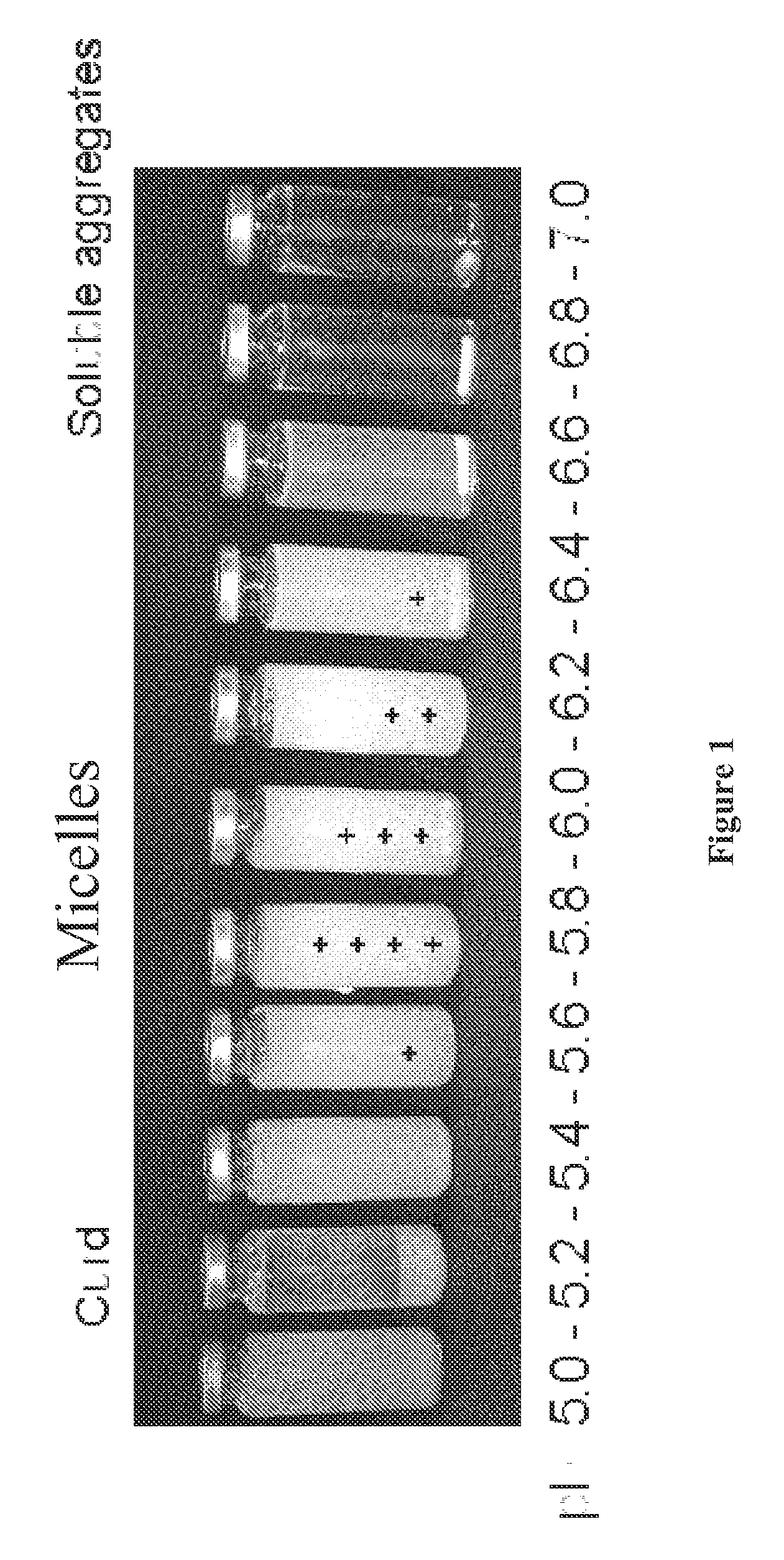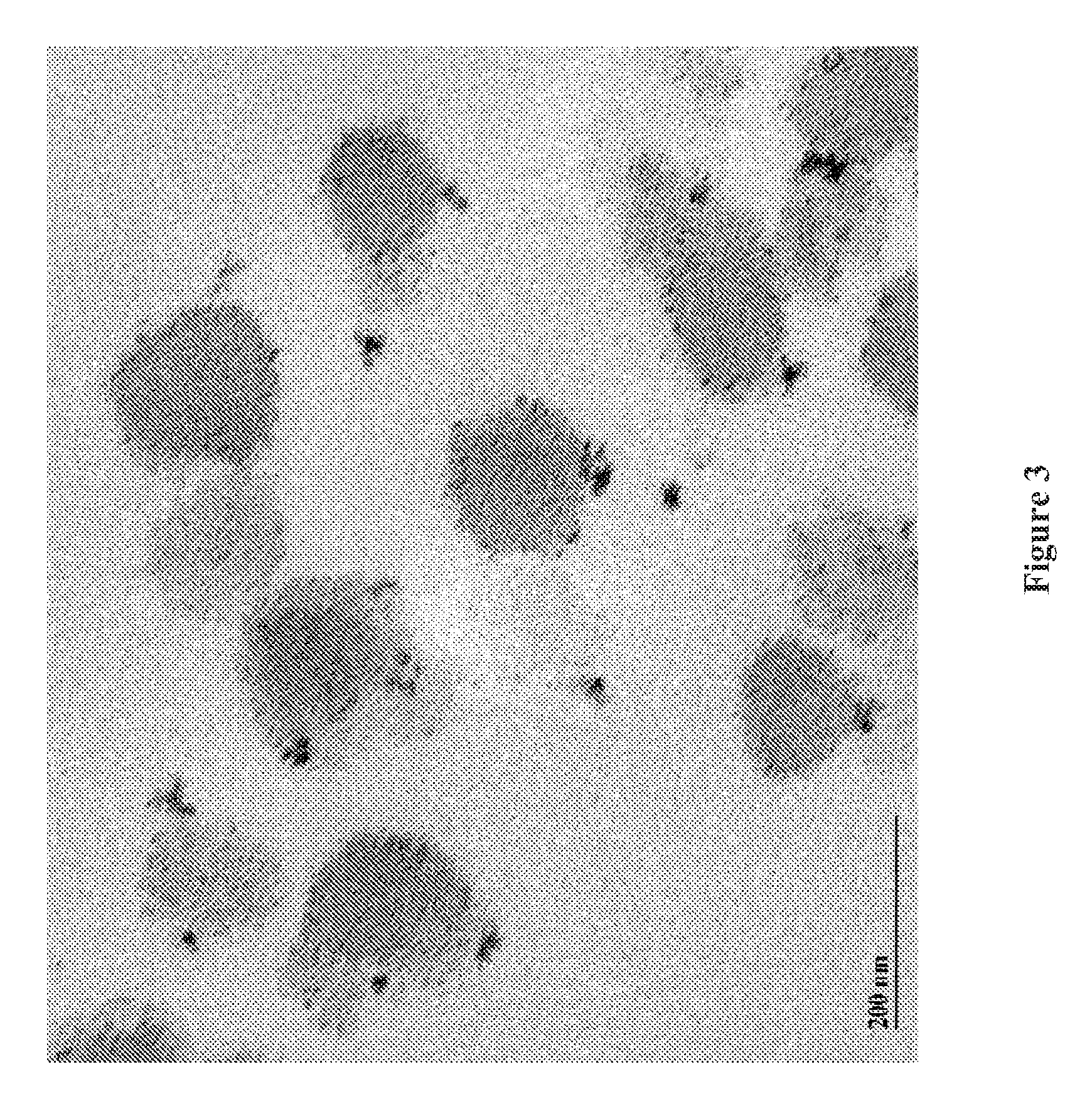Whey protein vehicle for active agent delivery
a technology of active agents and protein, applied in the field of whey protein micelles, can solve the problems of protein molecules, limited processability, and loss of native structur
- Summary
- Abstract
- Description
- Claims
- Application Information
AI Technical Summary
Benefits of technology
Problems solved by technology
Method used
Image
Examples
example 1
Micellisation of β-Lactoglobulin
[0142]β-Lactoglobulin (lot JE002-8-922, 13-12-2000) was obtained from Davisco (Le Sueur, Minn., USA). The protein was purified from sweet whey by ultra-filtration and ion exchange chromatography. The composition of the powder is 89.7% protein, 8.85% moisture, 1.36% ash (0.079% Ca2+, 0.013% Mg2+, 0.097% K+, 0.576% Na+, 0.050% Cl−). All other reagents used were of analytical grade (Merck Darmstadt, Germany).
[0143]The protein solution was prepared at 0.2% concentration by salvation of β-lactoglobulin in MilliQ® water (Millipore), and stirring at 20° C. for 2 h. Then pH of aliquots was adjusted to 5.0, 5.2, 5.4, 5.6, 5.8, 6.0, 6.2, 6.4, 6.6, 6.8, 7.0 by HCl addition. The solutions were filled in 20 ml glass vials (Agilent Technologies) and sealed with aluminum capsules containing a silicon / PTFE sealing. The solutions were heated at 85° C. for 15 min (time to reach the temperature 2.30-3.00 min). After the heat treatment, the samples were cooled in ice wat...
example 2
Micellisation of Whey Protein Isolate
[0145]Whey protein isolate (WPI) (Bipro®, Batch JE032-1-420) was obtained from Davisco (Le Sueur, Minn., USA). The composition of the powder is reported in table 2.
[0146]The protein solution was prepared at 3.4% protein by solvation of whey protein powder in MilliQ® water (Millipore), and stirring at 20° C. for 2 h. The initial pH was 7.2. Then pH of aliquots was adjusted at 5.6, 5.8, 6.0, 6.2, 6.4 and 6.6 by HCl 0.1N addition.
[0147]The solutions were filled in 20 ml glass vials (Agilent Technologies) and sealed with aluminum capsules containing a silicon / PTFE sealing. The solutions were heated at 85° C. for 15 min (time to reach the temperature 2.30-2.50 min). After the heat treatment, samples were cooled in ice water to 20° C.
[0148]The turbidity of heated whey proteins has been determined at 500 nm and 25° C., samples were diluted to allow the measurement in the range of 0.1-3 Abs unit (Spectrophotometer Uvikon 810, Kontron Instrument). Values ...
example 3
Microscopic Observation of Micelles
Production of Micelles:
[0151]Protein solution was prepared at 2% protein by salvation of whey protein powder (WPI 90 batch 989 / 2, Lactalis, Retier, France) in MilliQ® water (Millipore), and stirred at 20° C. for 2 h. Then pHs of aliquots were adjusted using HCl 0.1N or NaOH 0.1N.
[0152]The solutions were filled in 20 ml glass vials (Agilent Technologies) and sealed with aluminum capsules containing a silicon / PTFE sealing. The solutions were heated at 85° C. for 15 min (time to reach the temperature 2.30-2.50 min). After the heat treatment, the samples were cooled in ice water to 20° C. For this product the optimal pH for micellisation was 7.4.
Microscopic Observations:
[0153]Liquid micelle samples were encapsulated in agar gel tubes. Fixation was achieved by immersion in a solution of 2.5% glutaraldehyde in 0.1 M, pH 7.4 cacodylate buffer and post-fixation with 2% Osmium tetroxide in the same buffer, both solutions containing 0.04% Ruthenium red. Afte...
PUM
| Property | Measurement | Unit |
|---|---|---|
| molecular size | aaaaa | aaaaa |
| temperature | aaaaa | aaaaa |
| molecular size | aaaaa | aaaaa |
Abstract
Description
Claims
Application Information
 Login to View More
Login to View More - R&D
- Intellectual Property
- Life Sciences
- Materials
- Tech Scout
- Unparalleled Data Quality
- Higher Quality Content
- 60% Fewer Hallucinations
Browse by: Latest US Patents, China's latest patents, Technical Efficacy Thesaurus, Application Domain, Technology Topic, Popular Technical Reports.
© 2025 PatSnap. All rights reserved.Legal|Privacy policy|Modern Slavery Act Transparency Statement|Sitemap|About US| Contact US: help@patsnap.com



